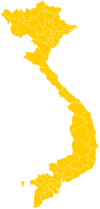Tonkin

Tonkin (Vietnamese: Bắc Kỳ, historically Đàng Ngoài), also spelled Tongkin, Tonquin or Tongking, is in the Red River Delta Region of northern Vietnam.
Names
"Tonkin" is a corruption of Đông Kinh (東京), the name of Hanoi during the Lê Dynasty. Locally, Tonkin is known as Bắc Kỳ, meaning "Northern Region".
The name was used in 1883 for the French colonial Tonkin protectorate, a constituent territory of French Indochina.
Geography
It is south of the Northeast Region of Vietnam, and of Yunnan and Guangxi Provinces of China; east of northern Laos; and west of the Gulf of Tonkin.
Located in the fertile delta area of the Red River, Tonkin is rich in rice production.

History
The area was called Văn Lang by Vietnamese ancestors from around 2000−100 BCE. Evidence of the earliest established society in northern Vietnam, along with the Đông Sơn culture, was discovered in the Cổ Loa Citadel area, the core of the ancient city of Cổ Loa. Its site is located near the historical city of Hà Nội and present-day Hanoi, the capital city of Vietnam.
According to Vietnamese myths the first Vietnamese peoples descended from the Dragon Lord Lạc Long Quân and the Immortal Fairy Âu Cơ. Lạc Long Quân and Âu Cơ had 100 sons before they decided to part ways. 50 of the children went with their mother to the mountains, and the other 50 went with their father to the sea. The eldest son became the first in a line of earliest Vietnamese kings, collectively known as the Hùng kings (Hùng Vương or the Hồng Bàng Dynasty). The Hùng kings called the country, which was then located on the Red River delta in present-day northern Vietnam, Văn Lang. The people of Văn Lang were referred to as the Lạc Việt.
15th century
Lê Lợi (reigned 1428–1433), a notable land owner in the Lam Kinh region, had a following of more than 1,000 people before rising up against the Chinese Ming dynasty. Following his victory he mounted the throne and established himself in the city of Thang Long ('Ascending Dragon') (former Cổ Loa, present Hà Nội). Thang Long was also called Đông Kinh (東京), meaning 'Eastern Capital'. (東京 is identical in meaning and written form in Chinese characters to that of Tokyo).[1][2]

18th & 19th centuries
During the 18th and 19th century, Westerners commonly used the name Tonkin (from Đông Kinh) to refer to northern Vietnam, then ruled by the Trịnh lords (while Cochinchina was used to refer to Southern Vietnam, then ruled by the Nguyễn lords, and Annam, from the name of the former Chinese province) was used to refer to Vietnam as a whole).[3]
After French assistance to Nguyễn Ánh to unify Vietnam under the Nguyen Dynasty, the French Navy began its heavy presence in the Mekong Delta and later colonized the southern third of Vietnam including Saigon in 1867.
During in the Sino-French War (1884–1885), Tonkin, then considered a crucial foothold in Southeast Asia and a key to the Chinese market, was invaded by the French in the Tonkin Campaign. It was colonized as the French protectorate of Tonkin, and was gradually separated from the French protectorate of Annam, with Vietnam being effectively separated into three parts.[4]
20th century
During French colonial rule within French Indochina, Hanoi was the capital of Tonkin protectorate, and in 1901 became the capital of all French Indochina (Cambodia, Laos, & Vietnam). French colonial administration ruled until 9 March 1945, with 1941-1945 during the World War II Japanese occupation of Vietnam. French administration was allowed by the Japanese as a puppet government. Japan briefly took full control of Vietnam in March 1945, as the Empire of Vietnam. Tonkin became a site of the Vietnamese Famine of 1945 during this period.[5]
After the end of World War II, French rule returned over French Indochina.
Northern Vietnam became a stronghold for the communist Viet Minh. Hanoi was later reoccupied by the French and conflict between the Viet Minh and France broke out into the First Indochina War. In 1949 it came under the authority of the State of Vietnam, a new Associated state of the French Union.
After the French defeat at the Battle of Dien Bien Phu in western Tonkin in 1954, the communist nation of North Vietnam was formed, consisting of Tonkin and northern Annam. The State of Vietnam's territory was reduced to the southern Vietnamese region, becoming South Vietnam.
See also
- North Vietnam topics
- Red River Delta Region topics
References
- ↑ Hữu Ngọc “Wandering through Vietnamese Culture”. Thé̂ giới publishers, 2004, reprinted April 2006 & 2008, 1 124 pp. ISBN 90-78239-01-8
- ↑ Forbes, Andrew, and Henley, David: Vietnam Past and Present: The North (History and culture of Hanoi and Tonkin). Chiang Mai. Cognoscenti Books, 2012. ASIN: B006DCCM9Q.
- ↑ Bruce McFarland Lockhart, William J. Duiker, The A to Z of Viêt Nam, Scarecrow Press, 2010, pages 40, 365-366
- ↑ Pierre Brocheux et Daniel Hémery, Indochine : la colonisation ambiguë 1858-1954, La Découverte, 2004, p. 78-81
- ↑ L'Indochine française pendant la Seconde Guerre mondiale, Jean-Philippe Liardet
External links
| Wikimedia Commons has media related to Tonkin. |
Coordinates: 21°00′00″N 106°00′00″E / 21.0000°N 106.0000°E
